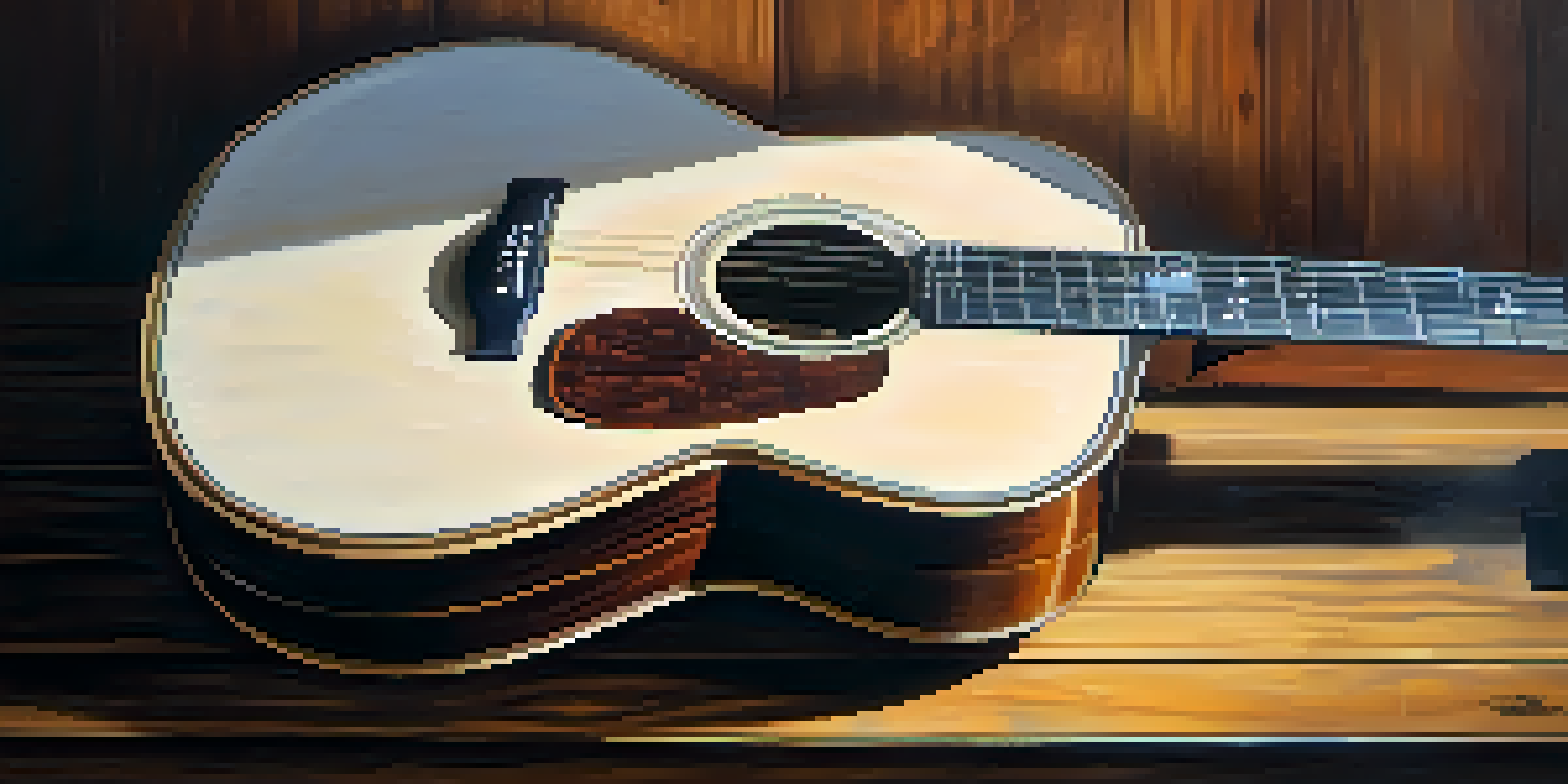Analyzing Song Techniques: Insights for Guitar Players

Understanding Song Structure: The Foundation of Music
Every song has a structure that serves as its backbone. Understanding common forms like verse-chorus and bridge helps guitar players anticipate changes and craft their parts effectively. For instance, a classic pop song often follows a simple structure, making it easier to learn and play.
Music is the shorthand of emotion.
Recognizing the sections of a song can also enhance your improvisation skills. When you know where the chorus is, you can plan your solos or riffs to build up to that moment. It’s akin to knowing the layout of a house; once you have a map, navigating becomes much simpler.
Moreover, understanding song structure can inspire your songwriting. By experimenting with different forms, you can create unique pieces that stand out. Remember, even the most complex songs have a clear foundation, so mastering this aspect can elevate your guitar playing.
Chords and Progressions: The Heart of Many Songs
Chords are the lifeblood of any song, providing harmony and emotion. For guitar players, mastering basic chords and common progressions is crucial. For example, the I-IV-V progression is found in countless songs, making it a must-know for any guitarist.

Experimenting with different chord voicings can also add depth to your playing. By shifting the same progression to different positions on the fretboard, you can create a fresh sound. Think of it like painting; the same colors can create different images when applied in various ways.
Mastering Song Structure Matters
Understanding song structures helps guitarists anticipate changes and enhances both improvisation and songwriting.
Understanding how chords interact within a key allows you to create tension and resolution. This knowledge can guide your playing, especially when soloing over chord changes. The more you practice, the more intuitive these transitions will become, enhancing your overall musicianship.
Melody Creation: Crafting Memorable Tunes
Melody is often what listeners remember most about a song. As a guitarist, learning how to create catchy melodies can set you apart. Consider using the pentatonic scale, a favorite among many guitarists, as it’s versatile and sounds great in various contexts.
The beautiful thing about learning is that no one can take it away from you.
Incorporating techniques like slides and bends can add expressiveness to your melodies. For instance, bending a note can evoke emotion, making the melody feel more dynamic. It’s similar to how a singer uses their voice to convey feelings; your guitar can do the same.
Listening to great melodies in songs can inspire your own creations. Try analyzing how your favorite guitarists build their melodies and incorporate similar techniques into your playing. This practice not only improves your creativity but also hones your ear for music.
Rhythm and Timing: The Pulse of Music
Rhythm is the foundation upon which music is built, and mastering it is essential for guitarists. Understanding different time signatures and learning to play in sync with a metronome can significantly improve your timing. Think of rhythm as the heartbeat of a song; without it, everything feels disjointed.
Experimenting with various strumming patterns can also enhance your rhythmic versatility. For example, a simple down-up strumming pattern can be transformed into a complex groove with syncopation. It’s like dancing; once you find your groove, everything flows better.
Chords Build Emotional Foundations
Mastering chords and progressions is crucial for creating harmony and depth in your guitar playing.
Improving your timing can also make you a better collaborator. When you play with others, solid timing ensures that everyone stays in sync, creating a cohesive sound. This skill not only enhances your playing but also makes jamming with friends more enjoyable.
Dynamics and Expression: Adding Emotion to Your Playing
Dynamics refer to the volume of your music and how it changes throughout a song. Mastering dynamics allows you to convey emotion, making your guitar playing more expressive. For instance, playing softly during a verse and building up to a powerful chorus can create an impactful experience for listeners.
Techniques like palm muting and fingerpicking can also affect the dynamics of your playing. Trying different approaches can bring a new layer of texture to your music. It’s like adding seasoning to a dish; the right touch can elevate the entire experience.
Listening to how other guitarists use dynamics can provide valuable insights. Pay attention to how they build intensity or create space in their playing. By incorporating these techniques, you can make your performances more engaging and memorable.
Improvisation: Finding Your Unique Voice
Improvisation is a powerful tool that allows you to express yourself on the guitar. By understanding scales and their relationships to chords, you can create solos that feel spontaneous yet grounded. It's like having a conversation; knowing the language helps you articulate your thoughts clearly.
Practicing improvisation regularly can boost your confidence and creativity. Start with simple exercises, like jamming over backing tracks, and gradually incorporate more complex ideas. Over time, you’ll develop a unique style that reflects your personality.
Improvisation Cultivates Unique Voice
Practicing improvisation allows guitarists to express themselves and develop a personal style that resonates with their personality.
Listening to improvisation by great guitarists can also inspire your own playing. Notice how they navigate through changes and create interesting lines. This practice not only enhances your skills but also encourages you to take risks and explore new musical ideas.
Analyzing Influential Guitarists: Learning from the Best
One of the best ways to improve as a guitarist is to study influential players. Analyzing their techniques, styles, and song structures can provide valuable insights into your own playing. For example, look at how Eric Clapton combines blues and rock, creating timeless riffs.
By learning songs from your favorite guitarists, you can dissect their approaches to melody, rhythm, and dynamics. It’s like reverse engineering; understanding the 'how' and 'why' behind their techniques can inform your own style. You’ll start to see patterns and principles that resonate with you.

Don't be afraid to incorporate elements from different guitarists into your playing. Blending various influences can lead to a unique sound that reflects your musical identity. Remember, every great guitarist was once a student, so keep learning and evolving.